(Tokyo) Faced with the spectacular increase in reservations for refuges on Mount Fuji, local officials have called for measures to limit crowds on this emblematic natural site of the Japanese archipelago, which is only accessible in summer .
Several local authorities and tourist associations have warned that an “unprecedented” number of hikers will attempt to climb the famous volcano this year, warning of the potential risks in a letter delivered Monday to the governor of Yamanashi prefecture, where the trail is located. most popular hike.
Visitation to Mount Fuji is expected to jump this year due to the lifting of COVID-19 restrictions and the full reopening of Japan’s borders, as well as the tenth anniversary of the listing of the active volcano as a UNESCO World Heritage Site. UNESCO.
Japan’s highest peak (3,776 meters), snow-capped for much of the year, is open to hikers from July to early September, attracting several hundred thousand people who often climb at night to see the sunrise from the top.
Those who fail to book a refuge could opt to climb the mountain without stopping, which “could increase the risk of altitude sickness and hypothermia”, the signatories of the letter warned.
Overcrowded paths also increase the risk of rockfalls, a city official from Fujiyoshida, one of the municipalities behind the call, told AFP.
“We are worried that Mount Fuji’s hiking season this year will create a terrible situation,” said the official, who requested anonymity.
She said she was particularly worried about foreign tourists who, unaware of the potential dangers of climbing the volcano, might want to climb it unprepared.
“We sincerely want them to be careful. There are deaths every year,” she added. “Climbing Mount Fuji is not that easy.”
The volcano, located about two hours by train from central Tokyo and visible from afar on clear days, has been immortalized in countless Japanese works of art, including the famous Big wave of the great master of prints Hokusai (1760-1849).
